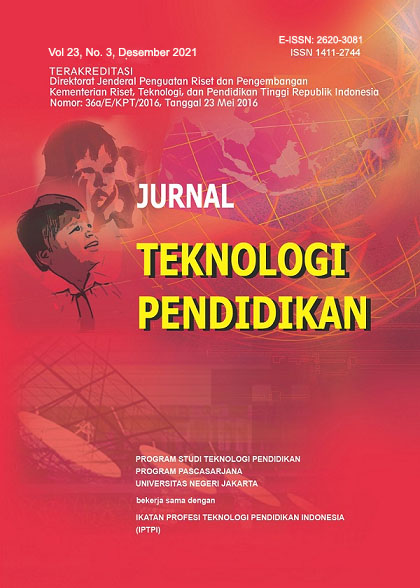A Learning Development Of Beauty Skill Program At A Vocational School In Preserving Local Wisdom
DOI:
https://doi.org/10.21009/jtp.v23i3.22826Keywords:
learning development, education management, local wisdomAbstract
A Learning Development Of Beauty Skill Program At A Vocational School In Preserving Local Wisdom. Objectives: The research is to analyze the learning development of beauty skill program at a vocational school in preserving local wisdom. Methods: to employ a qualitative approach with an analytically descriptive method towards two-state vocational schools in Kabupaten Bandung and Bandung city. Library research, in-depth interviews, a document study and observation were carried out to gather data. Informants were chosen by using a snowball technique, the findings, then, were examined and analyzed by using management theory by Deming, curriculum theory of social reconstruction and learning theory of constructivism by Vygotsky. Findings: Learning development planning of beauty skill at a vocation school in preserving local wisdom is designed by formulating vision and mission, arranging curriculum, providing more productive teachers and improving learning facilities. Learning development implementation is made by achieving student’s competence, involving experts and industrial and business world. Learning development is supervised by the Department of Education, Branch Department of Education West Java Provincial Government and school superintendent. The problem faced in learning development is the lack of productive subject time allotment, human resources and qualified teachers understanding local wisdom. The improvement is by enhancing industrial and business world cooperation and teaching factory, collaborating with professional, experts and practitioner organization, using subject time allotment and extracurricular activities. Conclusion: By learning development of beauty skill program in preserving local wisdom, it affects the quality improvement of graduates who have high awareness towards local wisdom, educational service improvement and the achievement of learning development implementation and the learning quality improvement.
References
BPS. (2020). Pendapatan Nasional Indonesia 2016-2020. Jakarta: BPS RI.
Brunning R.H., Schraw, G.J., & Ronning, R.R. (1995). Cognitive Psychology and Instruction, Edisi 2, Englewood Cliffs, NJ: Prentice Hall.
Creswell, John W. (2007). Qualitative Inquiry and Research Design, Second Edition. California: Sage Publication.
Darling, L. Hammond. (2005). Preparing Teacher for a Changing world, What Teachers should learn and be able to do. San Francisco; Jossey -Bass.
Hamalik, Oemar. (2006). Manajemen Pengembangan Kurikulum. Bandung: PT. Remaja Rosda Karya.
Handel, M. J. (2014). Skills Mismatch in the Labor Market. Annual Review of Sociologi JSTOR, 29(135), 65 –76. doi.org/10.1146/annurev.soc.29.010202.100030
Hersch, J. (2012). Education Match and Job Match. The Review of Economics and Statistics 73(1), 650–664. Retrieved from https://econpapers.repec.org/RePEc:tpr:restat:v:73:y:1991:i:1:p:140-44
Ma’mur, Asmani Jamal. (2012). Buku Panduan Internalisasi Pendidikan Karakter di Sekolah. Yogyakarta : Diva Press.
Mandalika, Syahril (2020). Pengembangan Media Pembelajaran Berbasis Video Tutorial Untuk Meningkatkan Efektifitas Pembelajaran Pada Mata Kuliah Tata Rias Pengantin Indonesia. INVOTEK Vol 20 No 1. https://doi.org/10.24036/invotek.v20i1.725
Miles, Matthew dan Huberman, A. Michael. (1992). Analisis Data Kualitatif: Buku Sumber Tentang Metode-Metode Baru. Jakarta:UI Press.
Moleong, Lexi J. (2001). Metodologi Penelitian Kualitatif. Bandung:Remaja Rosdakarya.
Olssen, Mark. (2004). Education Policy: Globalization, Citizenship and Democracy. London Sage Publications.
Putri, Astriani Eka. (2019). Analisis Kebutuhan Bahan Ajar Berbasis Literasi Digital Nilai- Nilai Kearifan Lokal pada Tradisi Saprahan di Pontianak. Yupa: Historical Studies Journal Vol. 3 No. 1, 2019 (1-7). https://doi.org/10.30872/yupa.v3i1.132
Rangkuti, Irmiah Nurul, Sitompul, Harun, Simbolon, Naeklan. (2018). Pengembangan Media Video Pembelajaran Rias Karakter Pada Program Studi Pendidikan Tata Rias. Jurnal Teknologi Informasi dan Komunikasi dalam Pendidikan. Vol.5, No. 1. https://doi.org/10.24114/jtikp.v5i1.12520
Salis, Edward. (2002). Total Quality Management in Education. London: Kogan Page Ltd.
Sari, Dian Maya dan Sipahutar, Esther Restie. (2014). Pengembangan Media Pembelajaran Interaktif Berbasis Blog Rias Wajah Sehari-Hari Tata Kecantikan Kulit. Jurnal Teknologi Informasi dan Komunikasi dalam Pendidikan. Vol 1, No.1. https://doi.org/10.24114/jtikp.v1i1.1870
Sarwendah, Zesi Zarmasi. (2016). Manifestasi Nilai Tradisional Riasan Pengantin. Kontemporer Dalam Mata Pelajaran Tata Rias Dan Kecantikan Di SMK. Keluarga: Jurnal Ilmiah Pendidikan Kesejahteraan Keluarga. Vol. 2, No. 2. Retrieved from https://jurnal.ustjogja.ac.id/index.php/keluarga/article/view/1936.
Slavin, R.E. (2000). Educational Psychology: Theory and Practice. Boston: Allyn and Bacon.
Sloane, P. J. (2013). Much Ado About Nothing? What Does The Over-Educatio Literature Really Tell Us?Overeducation in Europe: Current Issues in Theory and Policy, 45(3), 234–254. Retrieved from http://www.almalaurea.it/universita/pubblicazioni/wp
Subandijah. (1996). Pengembangan dan Inovasi Kurikulum. Jakarta: PT. Raja Grafindo Persada.
Sugiyono. (2010). Metode Penelitian Kuantitatif Kualitatif dan R&D. Bandung: Alfabeta
Sukarsi, Sri. (2014). Penggunaan Multimedia Interaktif dalam Upaya Meningkatkan Kreativitas Belajar Perawatan Kulit dan Rias Wajah Pada Siswa Kelas X Tata Kecantikan Kulit di SMK Negeri 3 Pati. Teknobuga. Vol.1. No. 2. https://doi.org/10.15294/teknobuga.v1i2.6414
Sukmadinata, Nana Syaodih.(2007), Metode Penelitian Pendidikan, Bandung; Rosda Karya.
Thune, Christian. (2001). European Network for Quality Assurance in Higher Education. Helsinki: Multiprint.
Downloads
Published
How to Cite
Issue
Section
License
Jurnal Teknologi Pendidikan is an Open Access Journal. The authors who publish the manuscript in Jurnal Teknologi Pendidikan agree to the following terms.
Attribution-ShareAlike 4.0 International (CC BY-SA 4.0)
-
Attribution — You must give appropriate credit, provide a link to the license, and indicate if changes were made. You may do so in any reasonable manner, but not in any way that suggests the licensor endorses you or your use.
-
ShareAlike — If you remix, transform, or build upon the material, you must distribute your contributions under the same license as the original.
- No additional restrictions — You may not apply legal terms or technological measures that legally restrict others from doing anything the license permits.
Notices:
- You do not have to comply with the license for elements of the material in the public domain or where your use is permitted by an applicable exception or limitation.
- No warranties are given. The license may not give you all of the permissions necessary for your intended use. For example, other rights such as publicity, privacy, or moral rights may limit how you use the material.








